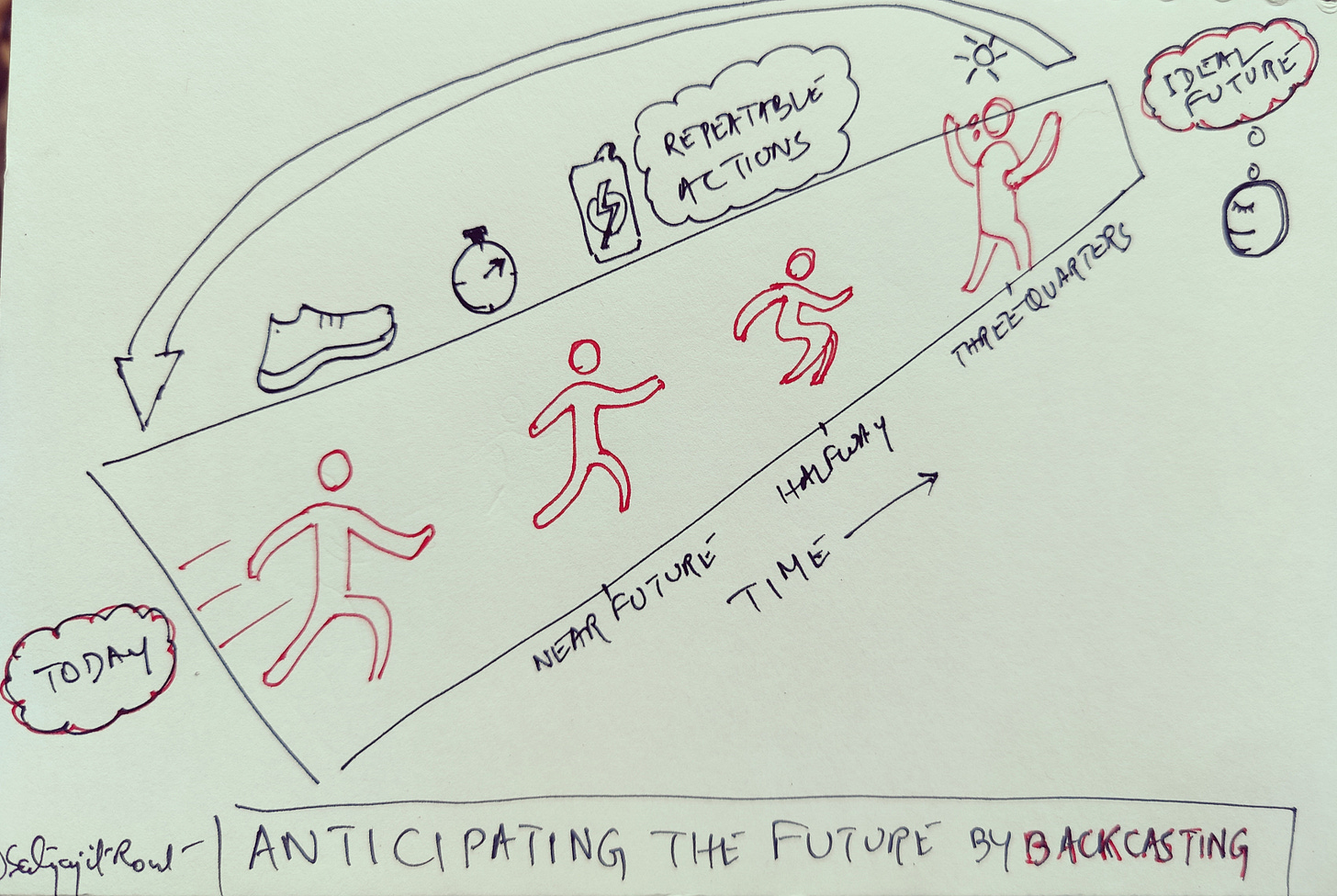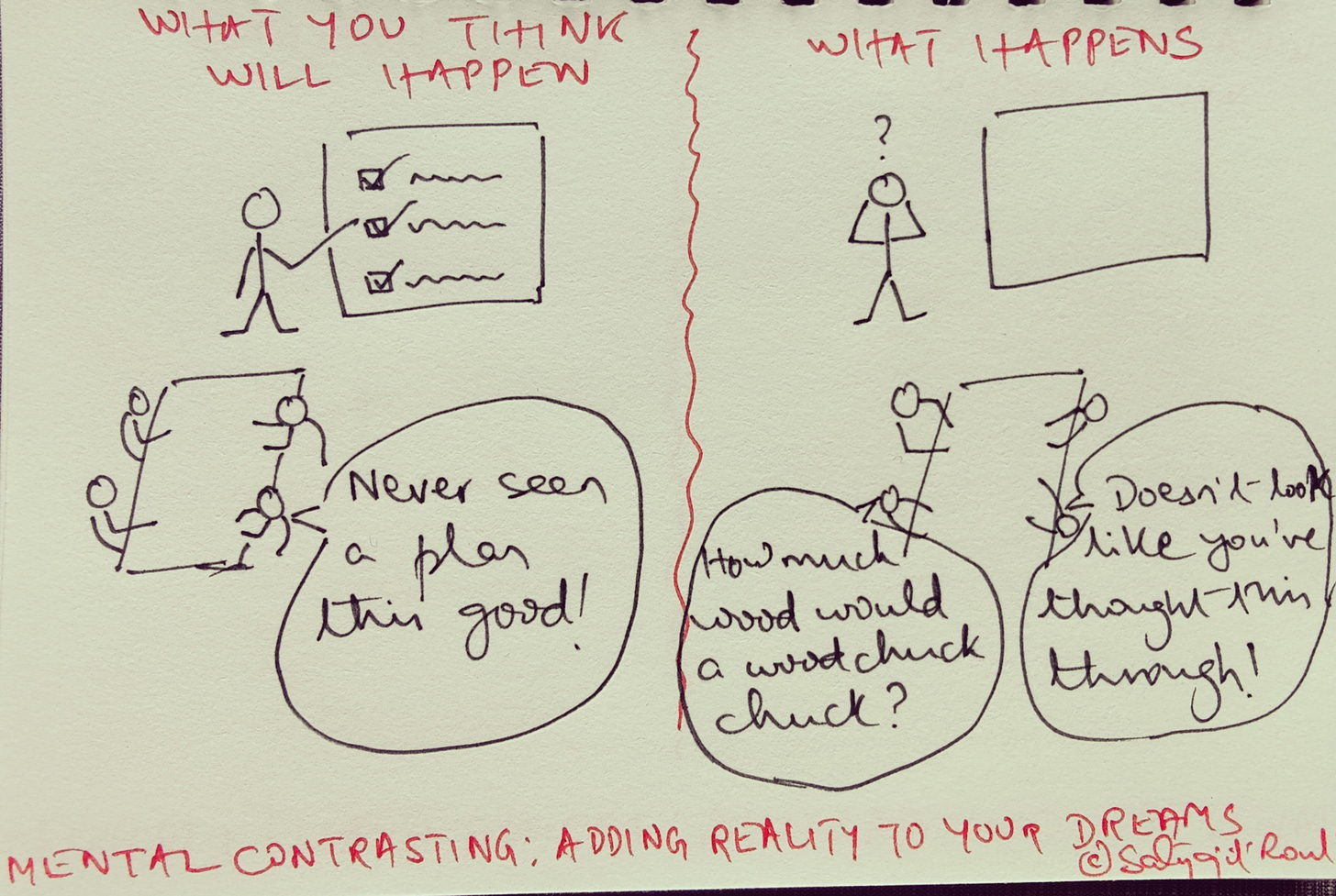Hi friends! 👋👋
Thank you for subscribing to Curiosity > Certainty! And welcome to Issue #43! This week I talk about time travel in decision-making.
We tend to simply extend present trends when thinking of the future. Imagine a time just before the discovery of electricity. How would a forecasting model for the future have looked? It would be about trends in household utilization of lamps and wicks and wax and oil for the next X years. We would have simply assumed that that trend would continue. But look at what happened. Electricity came along, and because of it, society transformed. The same goes for other inventions like the toaster (more breakfast, more productivity, more factories) or the elevator (taller buildings, denser population, more cities).
Present trends are not laws of nature.
Another common way we hit a snag when preparing for the future is we tend to only think positive. Our mental fantasizing is really that—fantasizing. Adding a dose of reality to our daydreams is therefore healthy. Positive thinking may feel good but it is negative visualization that saves us from surprise.
Here’s the first of two parts on how to travel across time to make better decisions.
Time Travel for Better Decision-Making
There’s a basic decision hygiene habit that few of us practise: time travel. It may sound outlandish, something you thought only happened in sci-fi dramas. It’s anything but.
Uncertainty is what makes decision-making a skill. Anticipating the future means reducing uncertainty. How can we anticipate the future while living in the present? Most of us make predictions. But we’ve got a shitty record at that, from electricity to elevators to covid. A better solution, as Annie Duke, author of Thinking in Bets says, is not to get caught up in our heads and travel across time.
Let me explain.
What if we can imagine an ideal future, place ourselves in it, and look back at the path that got us there? Positive visualization, but from the future all the way back to the present. This approach is known as 𝐛𝐚𝐜𝐤𝐜𝐚𝐬𝐭𝐢𝐧𝐠.
And now let’s add another dimension to our time travel: negative visualization. The worst-case scenario. Why just hope that we avoid the worst? Why not plan for it? Negative visualization prepares us for the obstacles we’ll inevitably meet along the way. There are two approaches that meet this brief: 𝐦𝐞𝐧𝐭𝐚𝐥 𝐜𝐨𝐧𝐭𝐫𝐚𝐬𝐭𝐢𝐧𝐠 and 𝐩𝐫𝐞𝐦𝐨𝐫𝐭𝐞𝐦𝐬.
And finally, and this is the last tool in the time travel toolbox, how about we imagine the unseen problems and opportunities created by every action we take? Everyone can see the immediate consequences. When everyone has thought the job’s done, how about we ask “And then what?” This is 𝐬𝐞𝐜𝐨𝐧𝐝-𝐨𝐫𝐝𝐞𝐫 𝐭𝐡𝐢𝐧𝐤𝐢𝐧𝐠.
I write on decision-making, habits, and mental models. If you like this post, or my writing in general, why not refer a friend who may enjoy it the same as you?
We’re all used to thinking forward and thinking positive. Scenario planning, forecasting, future mapping–all the ways you look at the future speaks to that. So why change?
I believe you should not change your forward-thinking and positive-thinking ways one bit. You should ignore this advice IF:
👉You’re certain about your prediction about the future
👉You’re certain that present trends are laws of nature and will continue
👉You’re certain the risk will always be within your threshold
👉You’re certain the cost of a wrong prediction is affordable
👉You’re certain you can course-correct no matter what
But if you’re curious to know how to reduce uncertainty and regret; how to be prepared for multiple futures; and how long-term change doesn’t sit well with predictions, then learning to do time travel for better decision-making may just be the thing for you. There’s a fat chance you’ll love it.
Backcasting
There’s a problem with the way we plan. The problem’s that we plan looking forward but we see better looking back.
What if you could imagine the end–end of a project, business plan, career switch? What if you could, as Shane Parrish says, make the hindsight of your future self the foresight of your current self? This is where a little reverse engineering helps. The general approach is called 𝐛𝐚𝐜𝐤𝐜𝐚𝐬𝐭𝐢𝐧𝐠.
‘I’ve always only forecasted and it’s worked out fine for me’. It’s not that forecasting is useless but that it works in a narrow set of circumstances. Forecasting works short-term when present trends are likely to continue. Stretch that on the time scale and the future is nothing like the past. Why didn’t we forecast COVID? Or social media? Or 9/11?
Backcasting doesn’t bother with predictions. Any meaningful future (career, relationships, business, health) is long-term and uncertain. So instead of asking ‘what will happen’, it helps you work out how something you want will happen.
All you need to do to backcast is reverse-engineer.
1️⃣ Place yourself in your ideal future. Capture detail. What do you feel like? What does the world around look like?
2️⃣ Write down what you did to get there. List specific actions/behaviors/decisions. Don’t say ‘I have to do this’; say ‘I did this’. Saying so brings ownership.
3️⃣ Now that you’ve a rough path of actions, you need signposts to hit. Where will you be:
👉Three-quarters of the way
👉Halfway (when will halfway come timewise)
👉In the near future from now
Here’s how I reverse-engineered a plan to prepare for and run six marathons south of 4:30 hours. I didn’t know the approach formally as backcasting but I followed the basic principle of it.
Curiosity is the start of a journey of discovery. Certainty is the culmination of it. I would rather be on this journey and learn. That’s why for me Curiosity > Certainty. If you feel the same, share it with a friend keen to learn to think better.
#1: My desired future state
I’ve run 42.195km in four hours. It’s warm, sunny, after 10am. I’m tired but I’ve got enough to savor the moment. I can walk and talk.
#2: Behaviors repeated to get to the end
I mirrored run times with the race-day time (only morning runs)
I ran 4 times a week for 12 weeks
I did my longest weekly run over the weekend
I upped my weekly mileage by 15-20%
I took no fluids for any sub-10km run
I did not miss my Sunday football matches
#3: Signposts along the 12-week program
Week 9: I did 31km in 2:45 (three-quarters)
Week 6: I did 21km in 1:45 (halfway)
Week 3: I did 10km in 0:50 (near future)
Though I aimed for a 4h finish each year, my times across six years were spread between 4 and 4:30. Looking back, I didn’t think much about nutrition and recovery. But I knew what was most important to me, and that was enough to bring me close to my goal each time.
You can make better decisions to get to your desired future if you fully understand all that is required to make it happen. Backcasting helps by placing you at the summit and identifying what’s needed each step of the way.
Mental Contrasting
You’re brushing your teeth in the morning and imagining an important presentation later in the day. You picture yourself setting the table for the problem, laying out the options, and winning the audience’s vote for a desired solution. You’ve quick answers and there’s not a moment you go off script. What may actually transpire, the reality of it is something that you don’t consider.
We often have a rigid framework for how events should pan out. And we will ourselves to believe through positive thinking that nothing outside that framework shall come to pass. So, we end up being surprised when it does because hey, this wasn’t supposed to happen.
Adding a dose of reality to your daydream is what makes it a plan. An actual plan for overcoming obstacles. This is an approach called 𝐦𝐞𝐧𝐭𝐚𝐥 𝐜𝐨𝐧𝐭𝐫𝐚𝐬𝐭𝐢𝐧𝐠.
Mental contrasting debunks the commonly held view that only thinking positive can lead to positive outcomes, and that negative thinking is primed to fail. Instead, Gabriele Oettingen, who first came up with the idea for mental contrasting, says that pairing 𝐩𝐨𝐬𝐢𝐭𝐢𝐯𝐞 𝐭𝐡𝐨𝐮𝐠𝐡𝐭 𝐰𝐢𝐭𝐡 𝐭𝐡𝐨𝐮𝐠𝐡𝐭 𝐚𝐛𝐨𝐮𝐭 𝐰𝐡𝐚𝐭 𝐦𝐚𝐲 𝐠𝐞𝐭 𝐢𝐧 𝐭𝐡𝐞 𝐰𝐚𝐲 𝐨𝐟 𝐭𝐡𝐞 𝐩𝐨𝐬𝐢𝐭𝐢𝐯𝐞 𝐟𝐮𝐭𝐮𝐫𝐞 𝐢𝐬 𝐜𝐫𝐮𝐜𝐢𝐚𝐥.
Now, back to the presentation. What could be some real barriers to winning for you?
Not ensuring everyone agrees on key assumptions
Answering the surface question, not the real one
Overcommitting
Not managing time
Not laying out clear next steps
Not thinking about who will execute the plan
Nerves that interfere with performance
Not anticipating ‘so what?’ and not having a response
Dealing poorly with personality issues, questioning styles
How can you practise mental contrasting for such a situation? Here’s a practice Oettingen refers to as WOOP. Write down:
𝐖 - What is your Wish?
𝐎 - What is your ideal Outcome?
𝐎 - What are the Obstacles?
𝐏 - What is your Plan to overcome the obstacles?
Once you do that, here may be some ways you come up with to overcome identified obstacles:
Have a self-talk routine (‘breathe and believe’)
Have a tension-release routine (two deep breaths and a smile)
Ask a question when you only get the surface question
Start with your plan’s weaknesses
Don’t get stuck at a point
Practise responses to things you’ve a habit of committing impulsively to
Prepare opening and closing your arguments
Be clear about the 1-2 clear decisions you want from the meeting
These responses could be a series of if-then statements (‘If I encounter obstacle X, I’ll respond with action Y’), something called implementation intentions.
Anticipating the future is anticipating the challenges it may bring and then making a plan to meet them. If you don’t want to be thrown off in your pursuit of your cherished goal, practise mental contrasting.
That’s it for this week. Thanks for reading!
Let me know what you made of the issue. I would be delighted to hear from you. Spread some ❤ by sharing it with a friend or two.
Until next week…






